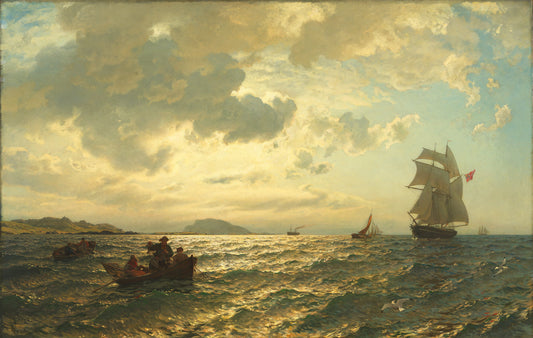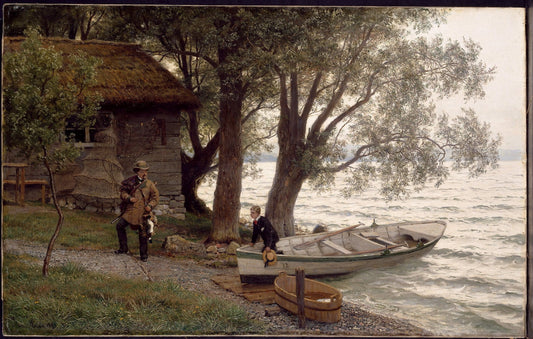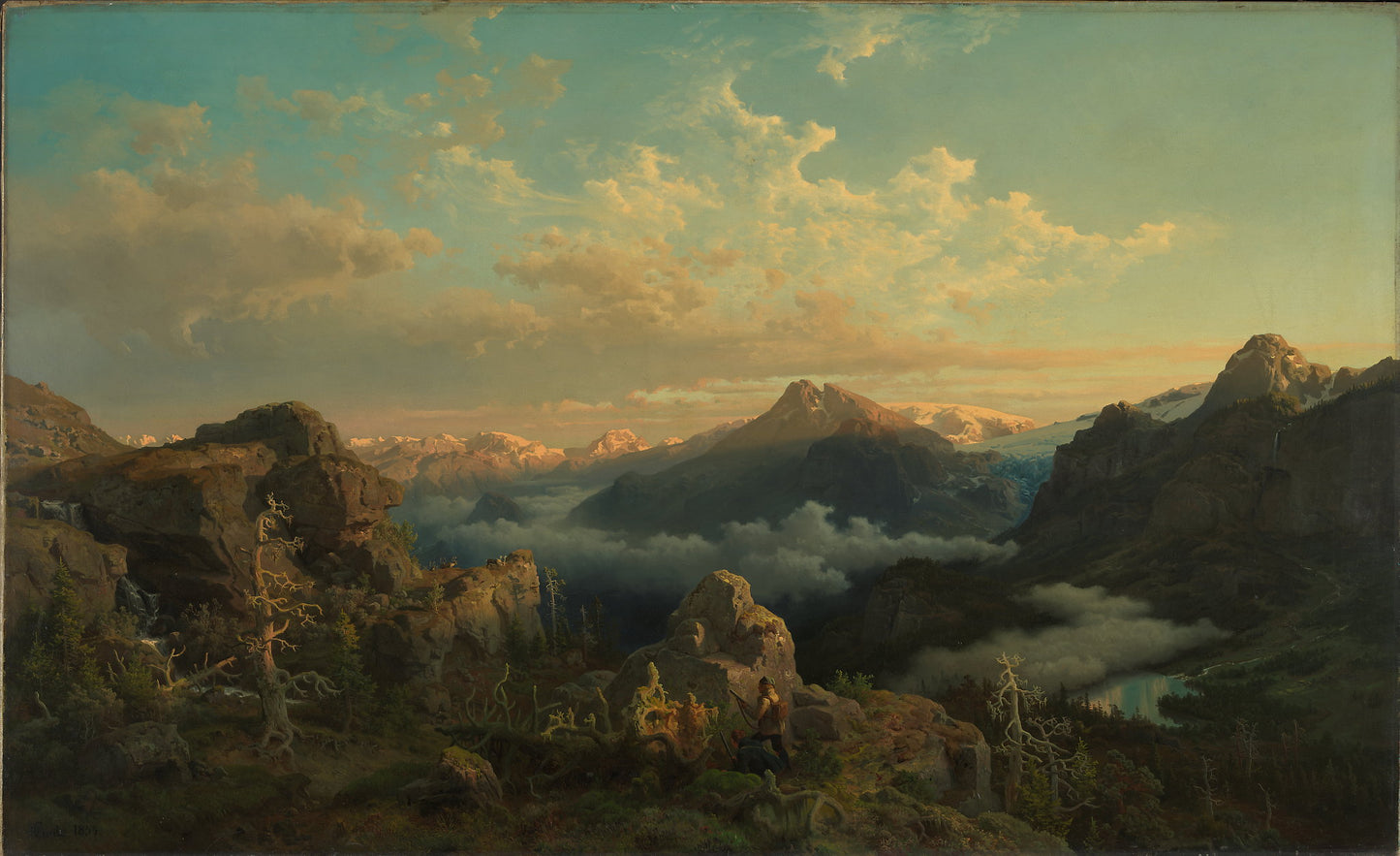Hans Gude
Høyfjell at sunrise
Høyfjell at sunrise
Pickup available at DÁIDDA galleri & printlab
Usually ready in 2-4 days
High-quality reproductions from the National Museum's collection. Posters by DAIDDA are printed on Litho White Matt - 230 gram photo paper in premium quality. Artprints by DAIDDA are printed on Moab Entrada Natural 300 gram cotton art paper in premium quality. Produced by DAIDDA.
About the original:
Date: 1854
Other titles: Norwegian Highlands in Sunrise (ENG)
Designation: Painting
Material and technique: Oil on canvas
Technique: Oil
Material: Canvas
Dimensions: H 100.2 cm x W 163.6 cm
Subject: Visual arts
Classification: 532 - Visual arts
Motif: Mountains
Subject type: Landscape, Cloud study
Acquisition: Gift from Thvorvald Meyer's daughters 1909
Inventory no.: NG.M.04186
Part of exhibition: Nature's mirror. Nordic landscape painting 1840-1910, 2007
Then Dahl and Munch. Romanticism, realism and symbolism in Norwegian landscape painting, 2001 - 2002
Nature's mirror. Nordic landscape painting 1840-1910, 2006
Nature's mirror. Nordic landscape painting 1840-1910, 2006 - 2007
A Mirror of Nature. Nordic Landscape Painting 1840-1910, 2007
Registration level: Single object
Owner and collection: The National Museum of Art, Architecture and Design, Visual Art Collections
Photo: Børre Høstland
Shipping and returns
Shipping and returns
Shipping: We deliver to Scandinavia, the EU, the USA and several other countries. Please contact us if your country is not listed and we will try to arrange delivery.
Delivery time: 2-5 days within Norway, 7 days in Europe, 14 days globally.
Packaging: Our products are made to order and sent rolled in environmentally friendly packaging.
Customs Fees: International orders may be subject to customs fees, which are not included in shipping costs.
Return policy: You can return images within 14 days. See our returns page for more information.
Secure Payment: We never store your payment details. See our privacy policy for details.
See all works
-
From Balestrand
Vendor:Hans GudeRegular price From 150,00 NOKRegular priceUnit price per -
Fresh breeze
Vendor:Hans GudeRegular price From 150,00 NOKRegular priceUnit price per -
The landing site in the garden of the poet Victor von Scheffel
Vendor:Hans GudeRegular price From 150,00 NOKRegular priceUnit price per -
 Sold out
Sold outFrom Balestrand
Vendor:Hans GudeRegular price 2.500,00 NOKRegular priceUnit price per3.400,00 NOKSale price 2.500,00 NOKSold out

His God
Hans Gude was one of Norway's leading and most important painters in the 19th century. Gude trained as a landscape painter in Düsseldorf and had his career as a painter and academy professor in the German cities of Düsseldorf, Karlsruhe and Berlin. Gude took many of his landscape motifs from Norway, and with magnificent depictions of Norwegian nature he became one of the most significant national romantic artists .
Together with Adolph Tidemand, he completed in 1848 Brudeferd i Hardanger, a picture that has been left as a nationally romantic masterpiece in Norwegian painting. During the 1860s, there was an interest in the production of water and the mirroring of water. A stronger realism can be felt in his pictures from this period, and marine painting became dominant in Gude's landscape art with many pictures from, for example, the Oslo Fjord and the coast of Rügen. Biography Hans Gude was the son of magistrate Ove Christian Gude and Marie Elisabeth Brandt. Gude showed an early interest in drawing and in 1837, aged just 12, became a private pupil of the landscape painter Johannes Flintoe. In the same year, he was accepted as a student at the School of Design, where Flintoe was a teacher. Two years later, he traveled over the mountains to Bergens Stift for the first time, and Gude tells in his autobiography how the experience of the snow-covered mountains made a strong impression on him. In the autumn of 1841 he traveled to Düsseldorf to study painting at the Academy of Fine Arts in the city. The period in Düsseldorf (1841–1862) Gude had originally planned to study history painting under Theodor Hildebrandt at the academy in Düsseldorf. But when he met Andreas Achenbach's art, his interest in landscape painting was awakened. Achenbach had been on a study trip to Norway in the summer of 1839, accompanied by Thomas Fearnley, and Gude had the opportunity to draw and paint after his Norwegian studies.
In the first year in Düsseldorf, Gude was a private pupil of Achenbach, before in the autumn of 1842 he was admitted to Johann Wilhelm Schirmer's landscape class at the Academy of Fine Arts. The landscape painters in Düsseldorf were very keen to carry out studies in nature, and the summers were spent drawing and painting these. They then formed the basis for the large landscape pictures that were mostly painted inside the studios in the winter. Gude was to do more of his nature studies in Norway. The first time he went on a study trip to Norway was in 1843. It was with impressions from this trip that in 1844 he was able to present the picture Høyfjell in the Christiania Art Association, a picture that marked his breakthrough as an artist in Norway. It was the high mountain that was the signature motif in the first years of his artistry, and his treatment of the Norwegian high mountain also brought him praise in the German press. In the high mountain pictures, we often find a dramatic expression with drifting clouds that cast shadows over the landscape, while streaks of sun penetrate the cloud layer and illuminate the mountain landscape in some parts. A major work is the National Gallery's Høyfjell from 1857. Gude is known for his joint works with Adolph Tidemand, the most famous of which is Brudeferd i Hardanger (a motif that has been executed in several versions). The first version was painted in Düsseldorf in the winter of 1847–1848 and was purchased for the Christiania Kunstforening and exhibited there in the summer of 1848. The picture has become the symbol of national romanticism in Norway with Tidemand's depictions of a bridal party dressed in buns in two boats, where Gude's sunny and dramatic Hardanger nature forms the background for the bridal cruise. The picture shows how specialized the education in painting was at this time; some painters (such as Tidemand) specialized in depictions of folk life, while others (such as Gude) were purely landscape painters. In 1854, Gude took over the position of professor of landscape painting at the academy in Düsseldorf after Schirmer. Here he also taught many Norwegian students, the most famous of whom is Erik Bodom. During the 1850s, Gude moved away from a romantic depiction of the high mountains, and he instead sought a more realistic representation with a background in thorough studies of nature. He now developed the sea as a new motif in his pictures, and from around 1860 coastal pictures became a central motif in his landscape art.
Gude had always been a specialist in landscape painting. But in Karlsruhe, after he had ended his collaboration with Adolph Tidemand, he also began to include people in his pictures. They are often called staff figures as they play a subordinate role compared to the depiction of the landscape. Nevertheless, they contributed to his images appearing more strongly as cultural depictions, often of fishermen's lives on the coast. Gude maintained his interest in depicting light and water, and from now on one can trace an influence from plein air painting through an increasing light power in his pictures. He often took his motifs from studies at German lakes such as Lake Constance and Chimsee, but above all coastal images from the Oslofjord came to dominate his artistic production in these years. He depicted the Oslo Fjord with small boats and sailboats and with a particular interest in how the light is refracted in the waves and reflected by the surface of the water. Sailing to Christiania from 1873 (Nasjonalmuseet/Nasjonalgalleriet) is a major work and clearly shows this interest in capturing the reflection of light on a troubled surface of water.







